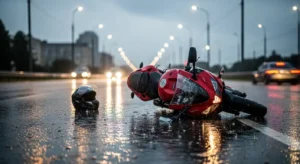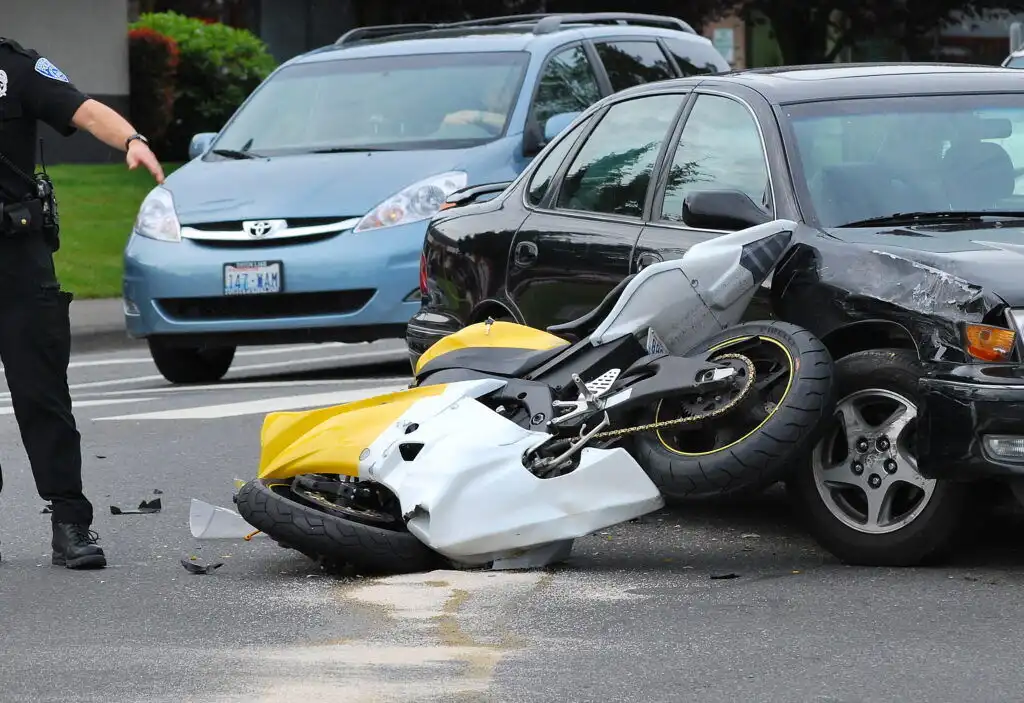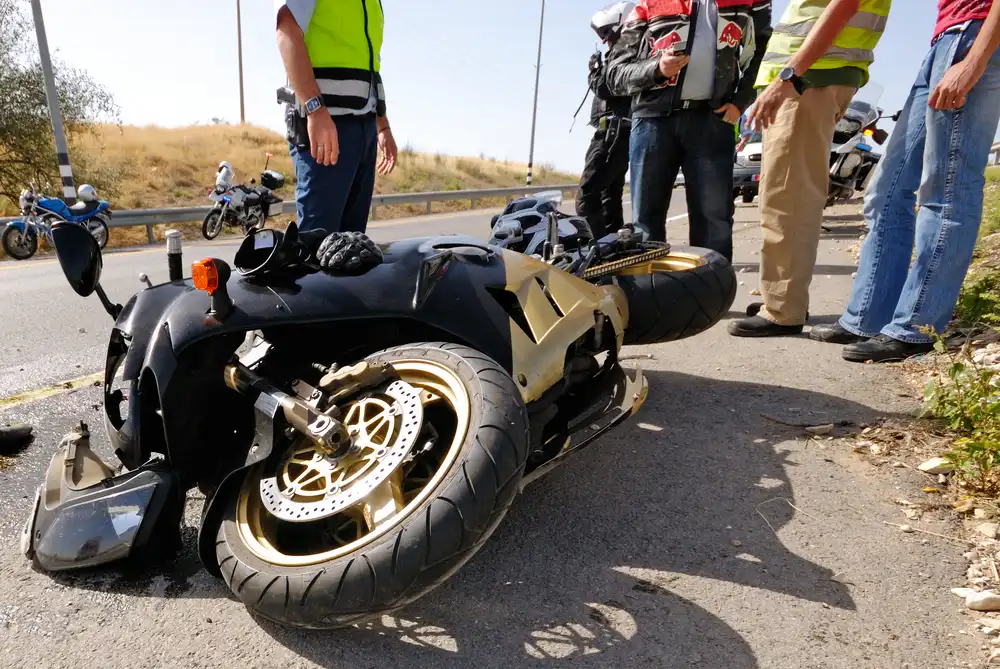Introduction
Motorcycling is one of the most exhilarating ways to travel, offering a sense of freedom that many riders cherish. However, the open road also comes with its risks. Weather conditions play a significant role in motorcycle safety, affecting visibility, road conditions, and the overall riding experience. For motorcyclists, understanding how different weather conditions impact safety is crucial to preventing accidents and improving survival rates in challenging situations.
Whether it’s rain, fog, snow, or extreme heat, the weather can dramatically alter the risk of an accident. In this blog post, we’ll explore the various weather conditions that can affect motorcycle accidents and provide valuable tips on how riders can reduce their risks when riding in such conditions.
The Impact of Rain on Motorcycle Accidents
Rain is perhaps the most common weather condition that affects motorcyclists. While some riders may be accustomed to riding in the rain, it’s essential to understand how wet conditions can increase the risks of an accident.
Reduced Traction
One of the primary dangers of riding in the rain is the reduction in traction. Wet surfaces cause the rubber of the tires to lose their grip on the road, which can result in slipping, especially when turning or braking. The first rain after a dry spell is particularly dangerous, as oil and debris have not yet been washed off the road. As a result, roads can become more slippery during the initial rainfall.
Decreased Visibility
Another hazard that rain presents is reduced visibility. Not only does rain obscure the rider’s vision, but it also makes it more difficult for other drivers to see the motorcyclist. In heavy downpours, visibility can be reduced to a few feet, making it difficult to anticipate turns, stop signs, or other obstacles.
In fact, studies by the National Highway Traffic Safety Administration (NHTSA) show that motorcycle accidents are 35% more likely to occur in rainy weather compared to dry conditions.
Safety Tips for Riding in Rain
- Slow Down: Reducing your speed gives you more time to react if you need to stop or make a quick maneuver. It also reduces the likelihood of skidding.
- Increase Following Distance: Wet roads can increase stopping distances, so allow extra space between your motorcycle and the vehicle in front.
- Use Waterproof Gear: Wearing waterproof clothing ensures comfort during the ride and keeps you visible to other drivers. Reflective jackets or vests help increase your visibility in poor weather.
- Check Tires: Ensure your tires have sufficient tread depth to handle wet conditions. Worn tires increase the risk of hydroplaning.

Fog: A Dangerous Weather Condition for Motorcyclists
Fog is another weather condition that poses significant risks to motorcyclists. It can severely limit visibility, making it hard for riders to spot potential hazards such as potholes, road debris, or other vehicles.
Reduced Visibility
The primary risk associated with fog is the reduction in visibility. In foggy conditions, the rider’s ability to judge distances and see what lies ahead is compromised. Fog can obscure road signs, lane markings, and other vehicles, making it difficult to anticipate what’s coming. The lack of visibility increases the likelihood of a collision, especially in areas with sharp curves or limited sightlines.
Difficulty in Spotting Motorcyclists
Motorcycles, being smaller than cars, are already harder for other drivers to spot on the road. Fog exacerbates this issue, making it harder for other drivers to see motorcyclists. In fact, studies have shown that motorcyclists are at a higher risk of being involved in accidents during foggy conditions due to their reduced visibility.
Safety Tips for Riding in Fog
- Use Low-Beam Headlights: High beams can reflect off the fog, making it harder to see. Low beams are designed for such conditions and provide better visibility.
- Reduce Speed: Riding too fast in fog can be deadly. Lower your speed to allow more time to react to any obstacles.
- Stay in Your Lane: Fog can make it difficult to judge lane positions, so stick to your lane and avoid unnecessary lane changes.
- Wear Anti-Fog Visors: Helmets with anti-fog visors or using a fog-resistant spray on your visor can help prevent your helmet from fogging up and impairing your vision.
- Pull Over if Necessary: If the fog becomes too thick to see more than a few feet ahead, pull over safely and wait for the fog to clear.
Snow and Ice: The Worst Weather for Motorcycles
Snow and ice present some of the most dangerous conditions for motorcyclists. These conditions make roads slippery and increase the risk of losing control, even for experienced riders. Even a slight layer of snow or ice can make riding nearly impossible.
Slippery Surfaces
When snow and ice are present on the road, traction is significantly reduced. Tires can lose grip, leading to skidding or a complete loss of control. Snow often hides hazards such as potholes, which could cause an accident if not seen in time.
Bridges and Overpasses
Bridges and overpasses are particularly dangerous in snowy and icy conditions. These structures freeze faster than regular roadways, and ice can persist on them even when the rest of the road is clear. Riders should be particularly cautious when crossing bridges or overpasses during the winter months.
Safety Tips for Riding in Snow and Ice
- Avoid Riding in Snow/Ice: If possible, avoid riding altogether during snow or ice conditions. Riding in these conditions significantly increases your risk of a crash.
- Use Proper Tires: Snow tires or tires designed for cold weather can help maintain better grip in winter conditions. Some riders opt for tire chains for additional traction on icy roads.
- Go Slow: Keep your speed to a minimum and maintain a greater distance from other vehicles. Stopping or turning quickly is nearly impossible in icy conditions.
- Wear Heated Gear: Cold weather riding requires proper protection. Invest in heated gear such as gloves, jackets, and socks to keep warm and maintain full control of your bike.

Extreme Heat and Motorcycle Accidents
While extreme heat may not immediately come to mind as a significant hazard for motorcyclists, it can still have a major impact on safety. High temperatures can cause dehydration, fatigue, and reduced concentration, all of which increase the risk of an accident.
Dehydration and Fatigue
Riding in the heat can cause riders to sweat profusely, leading to dehydration. Dehydration can impair concentration, slow reaction times, and reduce the rider’s ability to handle the motorcycle. In extreme cases, it can lead to heat exhaustion or heat stroke.
Heat-Related Motorcycle Malfunctions
Extreme heat doesn’t just affect the rider—it can also cause problems with the motorcycle. Overheating engines, tire blowouts, and brake failure are more common in hot weather. The heat can cause tires to wear down more quickly, reducing grip and increasing the chances of an accident.
Safety Tips for Riding in Extreme Heat
- Stay Hydrated: Drink plenty of water before and during your ride. Carry water bottles on long rides and take breaks when needed.
- Wear Lightweight Gear: Wear gear designed for hot weather that still offers protection. Lightweight, breathable fabrics help keep you cool while maintaining safety.
- Ride During Cooler Hours: Avoid riding in the heat of the day. Early mornings and evenings are often cooler, reducing the risks associated with extreme temperatures.
- Check Your Bike: Ensure your motorcycle is in good working condition, especially the tires and brakes. Overheated tires are prone to blowouts, which can be dangerous.

The Importance of Motorcycle Weather Awareness
Regardless of the weather condition, it’s essential for motorcyclists to remain aware of the environment around them. Forecasts can change quickly, and riders should be prepared for unexpected weather conditions during their trip. Regularly checking the weather before heading out can help motorcyclists make informed decisions about whether or not it’s safe to ride.
Weather Forecasting Technology
Many riders use weather apps or GPS devices that provide real-time updates on road conditions and forecasts. These tools can give riders a heads-up about potential rain, fog, or other weather hazards. Staying informed is the first step in ensuring safety.
Conclusion
Weather conditions have a profound impact on motorcycle accidents, and riders need to adjust their riding techniques accordingly. By understanding how different weather conditions affect riding, riders can take proactive steps to reduce their risk of accidents. While it’s not always possible to avoid bad weather, proper preparation, using the right gear, and adjusting riding habits can help motorcyclists stay safe and enjoy their ride.
If you’re planning to ride in less-than-ideal weather conditions, remember: slow down, stay visible, and always prioritize safety. The more prepared you are, the more likely you are to arrive at your destination safely.



